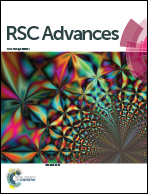Cyclic tetra[(indolyl)-tetra methyl]-diethane-1,2-diamine (CTet) impregnated hydrous zirconium oxide as a novel hybrid material for enhanced removal of fluoride from water samples†
Abstract
A hybrid material was prepared by incorporating cyclic tetra[(indolyl)-tetra methyl]-diethane-1,2-diamine (CTet) into hydrous zirconium oxide (HZO) via thorough mixing of previously prepared CTet in methanol and stirred for 7 h at 27 °C. CTet–HZO was characterized by FT-IR, 13C NMR, XRD, TGA-DTA, SEM coupled with EDX and TEM. The adsorption capacity of fluoride as a function of pH, sorbent dose, contact time, initial concentration of fluoride ions and temperature was examined in batch mode. Maximum fluoride adsorption (188.68 mg g−1) occurred in the pH range 3.5–4.5. The outstanding fluoride sorption property might be ascribed due to the presence of indole-NH groups. The Langmuir, Freundlich and Temkin isotherms were applied to fit the sorption equilibrium data. Based on R2 and average percentage error (APE), the best isotherm model fits follow the order: Freundlich > Temkin > Langmuir. The pseudo-second order kinetic model well fitted the sorption kinetic data which supported the chemisorption as the mechanism of interaction between sorbent and F−. The hybrid material could be reused upto four sorption–desorption cycles with no significant decrease in F− sorption capacity. The material has been applied successfully for the defluoridation of groundwater and river water.
![Graphical abstract: Cyclic tetra[(indolyl)-tetra methyl]-diethane-1,2-diamine (CTet) impregnated hydrous zirconium oxide as a novel hybrid material for enhanced removal of fluoride from water samples](/en/Image/Get?imageInfo.ImageType=GA&imageInfo.ImageIdentifier.ManuscriptID=C5RA01845E&imageInfo.ImageIdentifier.Year=2015)

 Please wait while we load your content...
Please wait while we load your content...